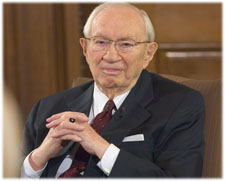
During the April 2005 General Conference of The Church of Jesus Christ of Latter-day Saints, LDS President Gordon B. Hinckley said, "This past decade has been a wonderful season in the history of the Church. There has been a remarkable flowering of the work. There have been many meaningful accomplishments."1 President Hinckley continued on to name several of these accomplishments including the building of temples, additional language translations of the Book of Mormon, and the building of the Conference Center in Salt Lake City, Utah. He also mentioned the numeric growth of Church membership, noting the increases in stakes and wards around the world. President Hinckley left the Latter-day Saints with a very rosy picture of the state of the LDS Church.
That's why it was so interesting to read a series of articles published by the Salt Lake Tribune in late July, 2005. Regarding LDS Church membership, these articles tell a decidedly different story. 2
Two and a half years ago LDS Apostle M. Russell Ballard announced that the Church was "raising the bar" on missionary standards. The intent was to send out better prepared and more effective missionaries; the result has been that the number of missionaries in the field has dropped significantly--from almost 62,000 to 51,000. The Salt Lake Tribune speculates that this fact may have contributed to a corresponding drop in LDS converts. In 2002, before raising the bar, the annual convert number was reported at nearly 285,000. In 2004 it had fallen to just over 240,000. According to LDS published statistics, the Church's growth rate dropped from 5 percent per year in the 1990s to 3 percent today.
If this is not enough to take some of the glow off President Hinckley's report, the problem the Church has with retaining its converts is even more sobering for Latter-day Saints.
A study by the Graduate Center of the City University of New York in 2001 revealed the LDS Church's net growth rate was zero percent. Of those surveyed, the number of people reporting they had joined the LDS Church was about the same as the number reporting they had left it.
Another example: In Brazil's 2000 census 199,645 citizens identified themselves as Latter-day Saints; but at the same time, the Church listed 743,182 Brazilians as members. The Church claimed almost 4 times the number of members that the census showed.
LDS researcher David G. Stewart, Jr. says, "It is a matter of grave concern that the areas with the most rapid numerical membership increase, Latin America and the Philippines, are also the areas with extremely low convert retention�Latter-day Saints lose 70 to 80 percent of their converts [in these areas]..."
According to the Salt Lake Tribune,
"Perhaps the best measure of LDS Church growth is the rate of new church units, such as wards (congregations) and stakes (like a diocese). Because they are staffed by volunteers, such units cannot function without enough active members.
"In 1980, The Ensign,...predicted that membership would grow from 4.6 million members at that time to 11.1 million members in 2000, and from 1,190 stakes to 3,600 stakes in 2000. While the number of members came very close to the projected value, there were 2,602 stakes worldwide at the end of 2002."
This shortfall of 1,000 stakes, even 2 years beyond the predicted date, would seem to support the idea that the Church has many more people on their membership rolls than in their meetinghouses on Sundays.
Even in Utah LDS Church membership is not what it used to be. Not long ago Utah was 70 percent LDS. As of 2004, the number stood at 62.4 percent. While the actual number of Church members continues to increase, the LDS share of the state population is in decline. The University of Utah and Brigham Young University agree that one factor contributing to this lower percentage is the fertility rate. Utah women do not have as many children as they used to, only surpassing the national average by half a percent. Another factor is the influx of non-Mormons into the state for economic reasons. But retention is also a problem in Utah. According to BYU professor Tim Heaton, between half and one-third of Utah Mormons on the membership rolls are not active in the Church.
We can only speculate on the reasons for the slowing Church growth rate and the huge number of Latter-day Saints who become inactive, yet it seems quite reasonable to think that the internet plays a significant role. Through Christian web sites people can obtain important information before they or their loved ones join the Church. As members, if they begin to have questions, they have a safe place to find answers and, sometimes, to find a friend.
Based on numbers reported in the Encyclopedia of Mormonism, David Stewart believes only 35 percent of LDS members worldwide are active. In other words, rather than Mormonism being 12 million strong, there are only 4 million active Latter-day Saints across the globe.
These membership statistics should encourage us to keep praying. It is good news that 65 percent of those who join the LDS Church do not remain in it; yet many--if not most of them--are still without a Savior. Pray for those who will bring them the Good News: that Jesus their Savior waits for them with open arms.